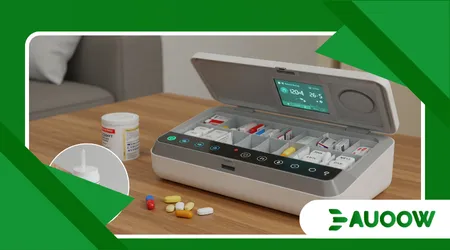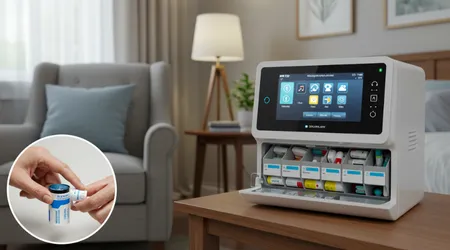Voice-Controlled Medication Dispensers: A Growing Trend in Elderly Care

Voice-Controlled Medication Dispensers are rapidly emerging as an indispensable technology in the realm of eldercare, moving beyond simple automation to offer a sophisticated layer of cognitive support.
These smart devices represent a critical bridge between medical necessity and user independence, dramatically improving adherence for seniors with complex schedules or mild cognitive decline.
Ignoring medication non-adherence, often described as a ‘silent epidemic,’ costs the healthcare system billions and severely compromises patient health.
The integration of voice commands addresses a key vulnerability: the physical and cognitive effort required to interact with traditional medical devices.
The shift toward intuitive, auditory interfaces is a recognition of the evolving needs of an aging population.
We are now seeing devices that don’t just remind you; they interact, confirm, and report, reducing the burden on both the user and the caregiver.
The market’s embrace of this technology is not just a trend; it is a fundamental restructuring of how we deliver care at home.
What are the Core Benefits of Voice-Controlled Medication Dispensers for the Elderly?
The primary advantage is the profound enhancement of medication adherence, directly addressing the fact that roughly half of patients with chronic conditions do not follow their long-term prescriptions.
By eliminating physical barriers and relying on simple spoken commands, the dispensers ensure the correct pill is released at the precise time.
How Does Voice Activation Increase Independence and Confidence?
Voice control empowers the user, offering a natural and accessible way to manage health tasks, a crucial factor in maintaining dignity and autonomy.
Seniors who might struggle with small buttons, complicated displays, or the fine motor skills required by traditional pill boxes find the hands-free nature of the device liberating.
The immediate audible confirmation of a dispensed dose reduces anxiety and the potential for “did I take my pill?” double-dosing errors.
A simple phrase like “Alexa, ask my dispenser when is my next dose?” provides instant reassurance, turning a moment of potential confusion into one of confidence. This feeling of self-efficacy is vital for mental health in the aging process.
When a user’s hands are full, or they are experiencing tremors from a condition like Parkinson’s, a Voice-Controlled Medication Dispensers becomes an essential tool, not just a convenience.
It transfers the control mechanism from the hand to the voice, significantly increasing the device’s accessibility footprint.
++ The Ethics of AI in Assistive Technology: Inclusion at the Design Stage
Why is Real-Time Communication Essential for Caregivers?
The ability of these dispensers to link caregivers and family members through a cloud-based app is revolutionary.
Caregivers receive instant, verifiable alerts if a dose is missed or delayed, enabling timely intervention without constant physical presence.
This remote monitoring capability significantly reduces the emotional and logistical stress on family caregivers, who can be miles away yet remain fully informed about their loved one’s adherence schedule.
The technology provides the priceless peace of mind that allows caregivers to manage their own lives while ensuring quality care for others.
Furthermore, the data collected provides granular adherence reports for healthcare providers, allowing doctors to make more informed decisions about treatment efficacy.
This data-driven approach replaces guesswork with facts, optimizing patient outcomes.

How Does the Integration of AI and IoT Elevate Dispenser Functionality?
Modern Voice-Controlled Medication Dispensers are sophisticated IoT (Internet of Things) devices, utilizing embedded AI and machine learning to optimize the user experience and security. This goes far beyond basic scheduling.
Also read: Exoskeletons at Home: From Rehabilitation to Daily Use
What Security Features Prevent Misuse and Tampering?
The best systems now incorporate advanced security features, including biometric authentication or voice recognition.
This ensures only the authorized user can access the medication, preventing accidental or intentional misuse.
This robust security layer is particularly important for high-potency medications, where access control is paramount for patient safety. The device essentially acts as a secure, personal micro-pharmacy locked down by the user’s voiceprint.
Moreover, if the device is tampered with or falls over, many systems can trigger an immediate alert to the caregiver and a monitoring center.
This proactive reporting is a game-changer for home safety, distinguishing them from simpler models.
Read more: The Rise of Brain-Computer Interfaces: A Glimpse into the Future
Can These Devices Handle Complex Medication Regimens?
Absolutely. The internal software can manage intricate, multi-medication schedules, adjusting for different times, frequencies, and even conditional dosing (e.g., “take with food”). They seamlessly integrate multiple prescriptions into one unified, manageable routine.
Consider an elderly patient managing diabetes, hypertension, and arthritis; their schedule might involve four different pills taken at seven unique times a day.
A modern Voice-Controlled Medication Dispensers can initiate a verbal request: “It is time for your afternoon dose of Metformin.”
The sophistication is evident in features like: “The Conditional Reminder,” where the device dispenses a blood thinner, but then immediately asks, “Have you eaten breakfast? Please confirm,” before dispensing a medication that requires food.
Why Is the Market Embracing Voice Control Technology?
The shift toward Voice-Controlled Medication Dispensers reflects broader trends in digital health and market recognition of the challenges presented by an aging global demographic. This demand is fueling significant growth.
What Does the Market Data Say About This Growth?
The market for smart pill dispensers is experiencing exponential expansion, reflecting the urgent need for adherence solutions.
According to a 2025 market analysis by The Business Research Company, the smart pill dispenser market is projected to grow from $3.15 billion in 2025 to $4.96 billion by 2029, with ‘voice-enabled smart dispensers’ specifically cited as a key trend driving this expansion.
This statistic confirms that voice-activated technology is moving from niche innovation to a core component of the smart health sector.
The move to voice control in medication dispensers is like the invention of the automated teller machine (ATM) for banking.
It takes a necessary, repetitive, and occasionally complex task (getting cash/taking medicine) and allows the user to complete it independently, securely, and outside traditional operational hours, granting unprecedented freedom.
Comparing Smart Medication Dispenser Generations
The evolution of automated medication management shows a clear progression toward greater autonomy and connectivity, with voice control representing the pinnacle of user-friendliness.
| Dispenser Type | Key Interaction Method | Primary Function | Caregiver Connectivity | Ideal User Profile |
| Traditional Pillbox | Manual Sorting/Opening | Physical organization | None | Highly independent, excellent memory. |
| Electronic Reminder | Button Presses, Alarms | Schedule reminders | Limited/Text Alerts | Mild memory lapse, good dexterity. |
| Automated Dispenser | Button Press/Lever Pull | Correct dosage release | Cloud-based Alerts | Complex schedules, limited dexterity. |
| Voice-Controlled Medication Dispensers | Voice Commands | Intuitive dispensing, Two-way communication | Real-time Data & Alerts | Cognitive decline, low dexterity, desire for independence. |
A modern Voice-Controlled Medication Dispensers can initiate a verbal request: “It is time for your afternoon dose of Metformin.”
If the user responds, “Wait five minutes,” the dispenser confirms, “Dose postponed for five minutes. Caregiver notified.”
This intelligent, two-way interaction replaces a harsh, impersonal alarm, fostering a positive relationship with the medical device.
Conclusion: Securing the Future of Independent Living
The rise of Voice-Controlled Medication Dispensers is more than a technological upgrade; it is an ethical imperative for supporting independent elderly living.
These devices effectively mitigate the critical risks associated with non-adherence and medication errors while maximizing user autonomy and caregiver peace of mind.
By simplifying the most crucial daily task taking medicine they are securing healthier, longer, and more dignified lives for our seniors. The shift to an accessible voice interface makes complex medical adherence surprisingly effortless.
Are we truly maximizing the safety and dignity of our elders if we fail to adopt proven, life-enhancing technologies like this? Now is the time to embrace this innovative standard of care.
Frequently Asked Questions (FAQ)
Are Voice-Controlled Medication Dispensers Covered by Insurance?
Coverage varies significantly. In many regions, they are classified as an assistive technology or durable medical equipment (DME), which may be covered by private insurance or government programs like Medicare/Medicaid, especially if prescribed by a physician to manage a chronic condition.
Consumers should check their specific policy in 2025.
How is the Voice Recognition Set Up for People with Speech Difficulties?
Leading manufacturers recognize this challenge. The devices are typically trained to recognize a specific voice pattern through multiple training sessions, often relying on acoustic patterns rather than perfect word articulation.
Many models retain physical buttons as a backup interface for users with severe speech impairments.
What Happens During a Power or Internet Outage?
Reputable Voice-Controlled Medication Dispensers operate with an internal battery backup and an offline clock, ensuring scheduled doses are still released on time.
Dispensing remains functional. While the remote notification features are paused during an internet outage, the device’s core safety function is maintained.
